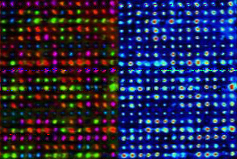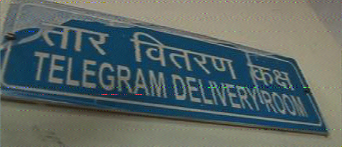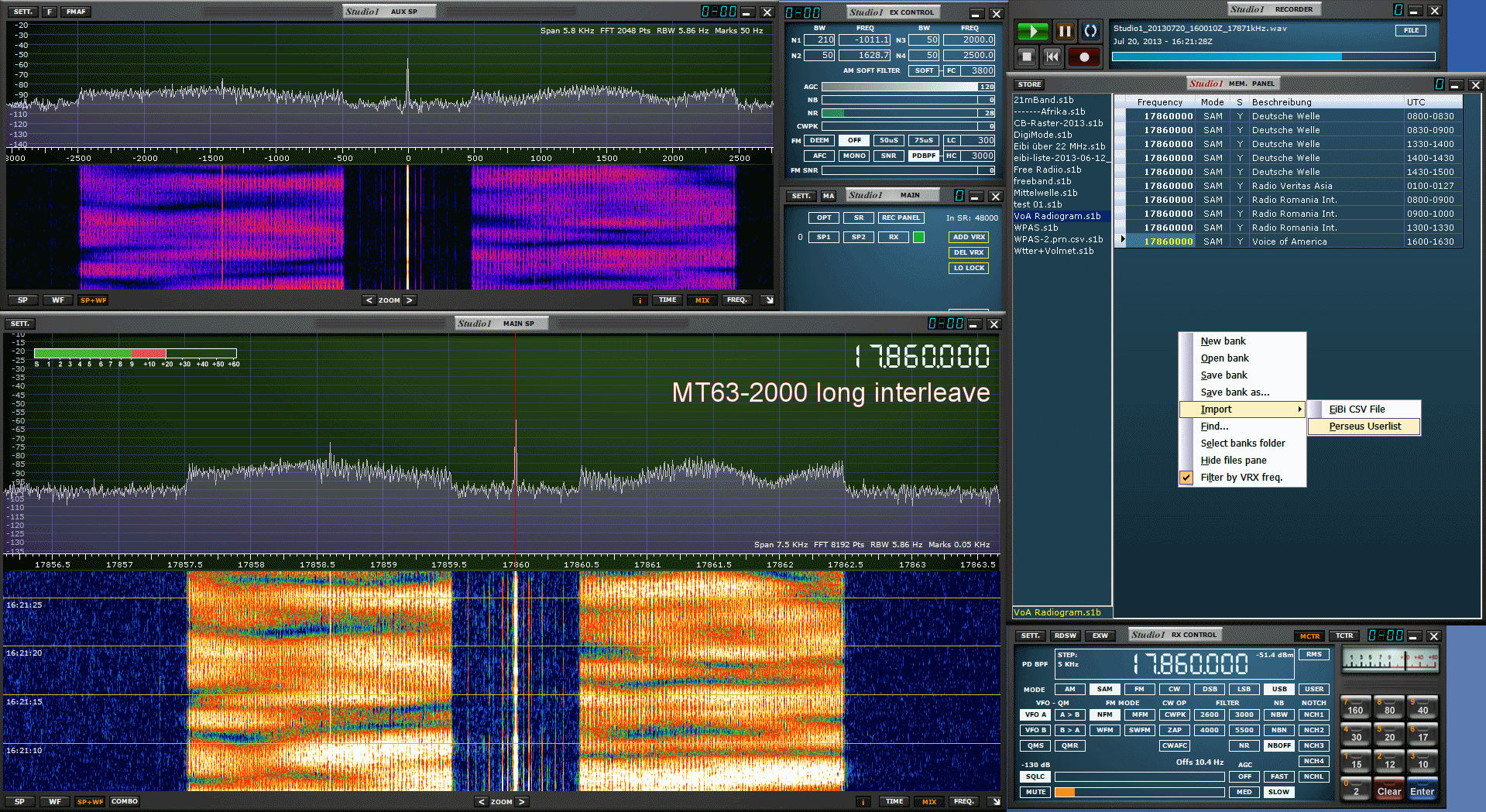www.rhci-online.net/radiogram/radiogram.htm
██╗ ██╗ ██████╗ █████╗ ██████╗ █████╗ ██████╗ ██╗ ██████╗ ██████╗ ██████╗ █████╗ ███╗ ███╗
██║ ██║██╔═══██╗██╔══██╗ ██╔══██╗██╔══██╗██╔══██╗██║██╔═══██╗██╔════╝ ██╔══██╗██╔══██╗████╗ ████║
██║ ██║██║ ██║███████║ ██████╔╝███████║██║ ██║██║██║ ██║██║ ███╗██████╔╝███████║██╔████╔██║
╚██╗ ██╔╝██║ ██║██╔══██║ ██╔══██╗██╔══██║██║ ██║██║██║ ██║██║ ██║██╔══██╗██╔══██║██║╚██╔╝██║
╚████╔╝ ╚██████╔╝██║ ██║ ██║ ██║██║ ██║██████╔╝██║╚██████╔╝╚██████╔╝██║ ██║██║ ██║██║ ╚═╝ ██║
╚═══╝ ╚═════╝ ╚═╝ ╚═╝ ╚═╝ ╚═╝╚═╝ ╚═╝╚═════╝ ╚═╝ ╚═════╝ ╚═════╝ ╚═╝ ╚═╝╚═╝ ╚═╝╚═╝ ╚═╝
http://voaradiogram.net/
RSID: <<2013-07-20T16:01Z
MFSK-16
@ 17860000+1500>>
Welcome to program 18 of VOA Radiogram from the Voice of America.
Here is the lineup for today's program
2:20 Program preview
4:31 MFSK16: VOA News re quartz glass for data storage
2:04 MFSK32: Image of data stored in silica glass
3:59 MFSK32: VOA News re end of India's telegram sevice
2:42 MFSK32: Image of sign at telegram office
2:53 MT63-2000L: VOA News re new materials for solar cells
2:32 MFSK64: Same VOA News re new materials for solar cells
1:10 MFSK32: Image of molecularspace.org logo
1:08 MFSK16: Closing announcements
1:11 Surprise image
Please send reception reports to radiogram@voanews.com
And visit voaradiogram.net
Twitter: @VOARadiogram
RSID: <<2013-07-20T16:04Z
MFSK-16
@ 17860000+1500>>
Sending Pic:330x30C;

RSID: <<2013-07-20T16:05Z
MFSK-16
@ 17860000+1500>>
Quartz May Be Used to Store Memory for Millions of Years
VOA News
July 11, 2013
British scientists say they have discovered a method for storing
and retrieving huge amounts of digital data that could last for
over a million years.
Using extremely short and intense pulses of laser light,
researchers at the University of Southampton assembled structures
in fused quartz glass that can withstand temperatures up to 1000
degrees Celsius.
The data, written in three layers of nanometer sized structured
dots, can be read by an optical microscope with polarized lenses.
A nanometer is one-billionth of a meter.
Scientists say the new method opens the possibility of creating
memory discs with an unprecedented memory capacity of up to 360
terabytes, with an almost unlimited lifetime.
Present long-time digital storage capacity based on hard-drive
memory storage has to be updated every five to ten years.
The new technology offers the possibility of preserving data
forever.
The discovery was presented at the Conference on Lasers and
Electro-Optics, in San Jose, California.
http://www.voanews.com/content/quartz-may-be-used-to-store-memory-for-millions-of-years/1699747.html
See also:
http://www.southampton.ac.uk/multidisciplinary/news/2013/07/9_5d_optical_memory_nanostrcutured_quartz_glass.page?
An MFSK32 image follows showing data as stored in silica
glass...
RSID: <<2013-07-20T16:10Z
MFSK-32
@ 17860000+1500>>
Sending Pic:237x159C;

RSID: <<2013-07-20T16:11Z
MFSK-32
@ 17860000+1500>>
+--------------------+
|VOA RADIOGRAM MFSK32|
+--------------------+
VOA NEWS
India Marks End of Era with Last Telegram
Aru Pande
July 15, 2013
NEW DELHI - Thousands of people crowded telegraph offices around
India to send the country's last telegrams, as the government
shut down the 163-year old service on Sunday.
Most Sunday afternoons, one would be hard-pressed to find anyone
at the Central Telegraph Office in New Delhi - let alone people
lined up in the rain. But this day is different. For engineer
Rasmeet Chawla - it is the end of an era.
"I am here for the same reason as everybody. This is the last
day, and I wanted to have a souvenir of this telegraph medium,"
he admitted.
Most of the people who crowded the office were young and have
grown up in the age of mobile phones and e-mail, technology that
eventually helped make the telegram obsolete.
But others like Neelima Chandak, who brought her 19-year old
daughter to the office, remembered the weight the small slip of
paper carried when it was finally delivered to its destination.
"Most of the time, it used to be anxiety. As soon as you heard
the word 'telegram,' you mostly associated it with news of death
and sometimes a job," she recalled.
On July 14, the last for the Central Telegraph Office in the
Indian capital, most of the telegrams carried nostalgic messages
and good wishes for loved ones. By late Sunday, with just a few
hours to go before the doors closed for good, 1,500 telegrams had
been processed - compared to 10 to 20 on any other day.
An employee for 31 years, Jagdish Chand joked the telegraph
service would never have incurred huge losses and be shut down
had it seen crowds like this through the years.
Still, he said he is proud to be part of a communication mode
that carried messages during India’s fight for independence and
was a vital part of Indians' day-to-day life.
"If someone had to be picked up at the railway station or from
the airport, the telegram used to reach [their loved ones' homes]
on the same day," he explained. "I was very happy that along with
doing my job, I was also doing a public service."
His service along with that of about 1,000 other workers across
India will no longer be needed. Many will either retire or be
transferred to other departments within state-owned
telecommunications company BSNL - which will continue its focus
on expanding Internet and mobile phone services across India.
http://www.voanews.com/content/india-marks-end-of-era-with-last-telegram/1701749.html
MFSK32 image follows: Sign at BSNL office in New Delhi...
RSID: <<2013-07-20T16:15Z
MFSK-32
@ 17860000+1500>>
Sending Pic:342x147C;

RSID: <<2013-07-20T16:18Z
MFSK-32
@ 17860000+1500>>
Please send reception reports to
radiogram@voanews.com
And visit voaradiogram.net
Twitter: @VOARadiogram
VOA Radiogram now changes to MT63-2000 long interleave...
RSID: <<2013-07-20T16:19Z
MT63-2000L
@ 17860000+1500>>
VOA NEWS
Volunteers Help Scientists in Search for Cheap Solar Cells
George Putic
July 15, 2013
Solar cells remain a relatively expensive investment for ordinary
consumers of electric power. But a group of scientists at Harvard
University is looking for cheaper, organic solar cells, which
could be painted on rooftops and building facades. In their
research, they are employing the help of thousands of volunteers
around the world.
Most of today's solar cells are silicon-based and their
manufacture requires sophisticated machinery and expertise. An
average home in the United States uses between 20 and 24 kilowatt
hours of electricity every day. And it may cost up to $20,000 to
buy and install solar panels that can produce that much energy.
While economical in the long run, it is an expense many cannot
afford.
But a group of researchers in the Harvard Clean Energy Project is
looking for cheaper, carbon-based compounds that could
substantially lower that price. Project head Alan Aspuru said
that a carbon-based solar cell would have to be about 10 percent
efficient to make an impact.
"This basically means that 10 percent of the sunlight that hits
the device is converted into energy. There's about three, or
four, or maybe five - a handful of molecules that we know about,
that already have this efficiency. And this has been discovered
in the last year or a couple of years," said Aspuru.
Aspuru says today's most commonly used silicon-based solar cells
also do not have a very high efficiency, just about 15 percent.
More-efficient solar cells do exist, but they are used mainly on
satellites, due to their high cost. But cheap carbon-based solar
cells could cover large surfaces - compensating for their low
efficiency.
Researchers already have identified 2.3 million carbon-based
compounds, out of which 35,000 potentially could have efficiency
above 10 percent.
"That does not necessarily mean that those 35,000 molecules, all
of them would be above 10 percent efficient. For a solar cell
that basically means they could potentially be, and more research
has to be done on them," he said.
Aspuru said further analysis of those compounds requires large
computing power, which his group is getting from volunteers
around the world who donate their computers' time to a "virtual
supercomputer" project.
"In my case, in partnership with [the] IBM project for the World
Community Grid, hundreds of thousands of people that are
registered in the database of IBM are on and off computing for
many projects, including ours," he said.
Researchers are hopeful their findings will spur innovation, and
that based on this research, experimental laboratories around the
world will be able to come up with new materials.
Results so far are encouraging. The Clean Energy Project already
has discovered a powerful organic semiconductor named DA2T. It's
the second best semiconductor reported in scientific literature.
http://www.voanews.com/content/volunteers-help-scientists-in-search-for-cheap-solar-cells/1702194.html
See also http://cleanenergy.molecularspace.org
RSID: <<2013-07-20T16:21Z
MT63-2000L
@ 17860000+1500>>
Next on VOA Radiogram, the same VOA News story in MFSK64...
RSID: <<2013-07-20T16:22Z
MFSK-64
@ 17860000+1500>>
VOA NEWS
Volunteers Help Scientists in Search for Cheap Solar Cells
George Putic
July 15, 2013
Solar cells remain a relatively expensive investment for ordinary
consumers of electric power. But a group of scientists at Harvard
University is looking for cheaper, organic solar cells, which
could be painted on rooftops and building facades. In their
research, they are employing the help of thousands of volunteers
around the world.
Most of today's solar cells are silicon-based and their
manufacture requires sophisticated machinery and expertise. An
average home in the United States uses between 20 and 24 kilowatt
hours of electricity every day. And it may cost up to $20,000 to
buy and install solar panels that can produce that much energy.
While economical in the long run, it is an expense many cannot
afford.
But a group of researchers in the Harvard Clean Energy Project is
looking for cheaper, carbon-based compounds that could
substantially lower that price. Project head Alan Aspuru said
that a carbon-based solar cell would have to be about 10 percent
efficient to make an impact.
"This basically means that 10 percent of the sunlight that hits
the device is converted into energy. There's about three, or
four, or maybe five - a handful of molecules that we know about,
that already have this efficiency. And this has been discovered
in the last year or a couple of years," said Aspuru.
Aspuru says today's most commonly used silicon-based solar cells
also do not have a very high efficiency, just about 15 percent.
More-efficient solar cells do exist, but they are used mainly on
satellites, due to their high cost. But cheap carbon-based solar
cells could cover large surfaces - compensating for their low
efficiency.
Researchers already have identified 2.3 million carbon-based
compounds, out of which 35,000 potentially could have efficiency
above 10 percent.
"That does not necessarily mean that those 35,000 molecules, all
of them would be above 10 percent efficient. For a solar cell
that basically means they could potentially be, and more research
has to be done on them," he said.
Aspuru said further analysis of those compounds requires large
computing power, which his group is getting from volunteers
around the world who donate their computers' time to a "virtual
supercomputer" project.
"In my case, in partnership with [the] IBM project for the World
Community Grid, hundreds of thousands of people that are
registered in the database of IBM are on and off computing for
many projects, including ours," he said.
Researchers are hopeful their findings will spur innovation, and
that based on this research, experimental laboratories around the
world will be able to come up with new materials.
Results so far are encouraging. The Clean Energy Project already
has discovered a powerful organic semiconductor named DA2T. It's
the second best semiconductor reported in scientific literature.
http://www.voanews.com/content/volunteers-help-scientists-in-search-for-cheap-solar-cells/1702194.html
See also http://cleanenergy.molecularspace.org
image follows: Logo from molecularspace.org, which
includes the Harvard Clean Energy project...
RSID: <<2013-07-20T16:24Z
MFSK-32
@ 17860000+1500>>
Sending Pic:134x149C;

VOA Radiogram now changes to MFSK16 for closing announcements...
RSID: <<2013-07-20T16:26Z
MFSK-16
@ 17860000+1500>>
Please send reception reports to radiogram@voanews.com.
And visit voaradiogram.net.
Twitter: @VOARadiogram
Thanks to colleagues at the Edward R. Murrow shortwave
transmitting station in North Carolina.
I'm Kim Elliott. Please join us for the next VOA Radiogram.
This is VOA, the Voice of America.
RSID: <<2013-07-20T16:27Z
MFSK-16
@ 17860000+1500>>
Sending Pic:16x642;

www.rhci-online.net/radiogram/radiogram.htm
http://voaradiogram.net/page/41
VOA Radiogram transmission
schedule
(all days and times UTC)
Sat 1600-1630 17860 kHz
Sun 0230-0300 5745 kHz
Sun 1300-1330 6095 kHz
Sun 1930-2000 15670 kHz
All via the Edward R. Murrow transmitting station in North Carolina.




